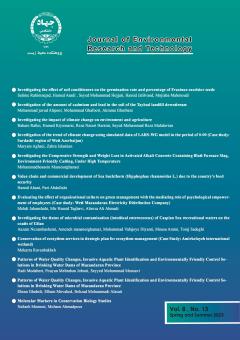-
-
-
Open Access Article
1 - Quantity and quality investigation of generated wastes at steel industries
Zahra Zamiraei علی ناهدRegarding to the variety of uses of steel in the world and widening its scope of application with the advancement of technology, steel production has changed to keep pace with advances in technology, following the changes; producers have tried to raise productivity and MoreRegarding to the variety of uses of steel in the world and widening its scope of application with the advancement of technology, steel production has changed to keep pace with advances in technology, following the changes; producers have tried to raise productivity and use of cheaper energy and fuels due to its geographical environment. There are the wastes in different stages of steelmaking (coke making, iron making and steelmaking). The generated wastes in this industry are with hazardous substances such as heavy metals, according to the classifications of the wastes, are classified as hazardous wastes. Therefore, identification and analysis and management of such waste in these industries are essential. The release of aforesaid hazardous wastes in nature can be had issues and problems for the environment and human health ultimately exceed the acceptable environmental conditions. The proper management of hazardous wastes in order to reduce and control pollution of the environment is utmost importance. Manuscript profile -
Open Access Article
2 - Waste Management of Petrochemical Industries and Its Management
زهرا ضمیرایی علی ناهدNatural gas and crude distillates such as naphtha from petroleum refining are used as feedstocks to manufacture a wide range of petrochemicals that are in turn used in the manufacture of consumer goods. Petrochemical plants are typically l MoreNatural gas and crude distillates such as naphtha from petroleum refining are used as feedstocks to manufacture a wide range of petrochemicals that are in turn used in the manufacture of consumer goods. Petrochemical plants are typically large and complex, and the combination and sequence of products manufactured are often unique to the plant. Petrochemical plants generate significant amounts of solid wastes and sludges, some of which are hazardous because of the presence of toxic organics and heavy metals. A good practice target for a petrochemical complex is to reduce total organic emissions (including VOCs) from the process units to 0.6% of the throughput. In this paper a variety of control of air emissions techniques is has been studied. Petrochemical waste waters often require a combination of treatment methods to remove oil and other contaminants before discharge. For solid and hazardous wastes, combustion (preceded in some cases by solvent extraction) of toxic organics is considered an effective treatment technology for petrochemical organic wastes. Steam stripping and oxidation are also used for treating organic waste streams. The generation of sludges should be minimized. Wastes containing toxic metals should be stabilized before disposal. Manuscript profile -
Open Access Article
3 - Investigation of environmental effects of rubber waste and proposed methods in the management of this type of wastes
علی ناهدRubber is one of the materials that are widely used in industry and when they expire, they fall into the category of hazardous wastes. The release of rubber wastes into the environment causes many problems, including diseases, their bad landscape in nature, and terrible MoreRubber is one of the materials that are widely used in industry and when they expire, they fall into the category of hazardous wastes. The release of rubber wastes into the environment causes many problems, including diseases, their bad landscape in nature, and terrible fires caused by their accumulation and environmental pollution. Also, rubber can be reused due to its non-degradability and elastic properties; as a result, the management of worn tires has a particular importance. There are several ways to manage rubber waste that can be safe and effective when done properly. These methods include sanitary landfilling, incineration, pyrolysis, milling, reuse at various scales, and re-coating. In this article, each method is reviewed and their advantages and disadvantages are stated. Also, there are examples of different applications of rubber waste in various industries. Manuscript profile
List of Articles
-
The rights to this website are owned by the Raimag Press Management System.
Copyright © 2017-2024


